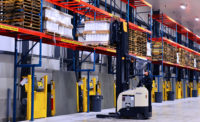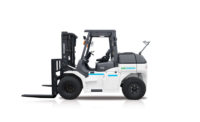Distribution centers are projected to need 452,000 more workers by 2020—thanks largely to rising consumer demands and e-commerce sales, according to research conducted by CBRE Group, Los Angeles. However, studies also show that the demand for workers is quickly outpacing the labor supply. Many facilities are left struggling with staffing shortages amid intense competition from limited labor pools. These shortages are especially tough on warehouses where employees are expected to manually pick and prepare orders for dispatch.
Manual warehouse workers must work harder and faster just to keep orders moving out the door.
Firing on all cylinders, they become highly susceptible to physical burnout, or worse, injury. The risks are particularly high in refrigerated or frozen distribution centers, given the weights of the loads being handled. The Occupational Safety and Health Administration (OSHA), Washington, D.C., notes weights upwards of 80-100 pounds are not uncommon.
That’s why more and more distribution centers are turning to automation to help combat the labor shortage and minimize risks for injury.
Automation can help facilities run at their best—year-round—filling in the operational gap between workforce demand and labor supply. With automated systems performing more of the physically demanding work of order fulfillment, ergonomic conditions and workplace safety vastly improve for current staff members.
Automate for a safer workplace
The International Labour Organization, Switzerland, estimates that 340 million occupational accidents happen around the world each year. According to the Bureau of Labor Statistics, Washington, D.C., 5 out of 100 warehouse workers end up suffering an injury or illness—a statistically higher margin than other occupations. Common distribution center injuries stem from forklift accidents, over-exertion, repetitive strain injury, falls or falling objects.
With the risks so high, distribution centers need to be mindful of the growing regulations regarding worker safety. Many industrialized nations are implementing directives and regulations designed to protect the safety of warehouse workers. For example, the European Union has a directive specifically outlining the “minimum health and safety requirements for the manual handling of loads where there is a risk particularly of back injury to workers.”
OSHA continues to develop regulations that lay out expectations and procedures for workplace safety.
In Canada, the Canadian Centre for Occupational Health and Safety advises using mechanical aids, such as automation, to improve safety whenever and wherever possible.
Globally, the growing trend is that it will ultimately be up to distribution centers themselves to reduce safety risks and protect the well-being of their employees. While regulatory requirements and training on proper lifting techniques can help decrease the number of accidents, automation can make a larger difference by taking over the majority of order picking and fulfillment and redirecting staff to higher-value tasks. These include the supervision of operations, the release of orders, selection of order picking sequences, transport planning, managing product shortages and maintenance. When people need to pick products, it is usually only for ones with special handling requirements.
Automate for better ergonomics
In traditional distribution centers, manual order picking subjects the human body to strenuous, repetitive tasks, including twisting, bending, reaching and lifting. This puts staff at constant risk of injury and long-term damage due to years of prolonged physical stress. According to National Institute for Occupational Safety and Health, Canada, “approximately one in every four Canadians whose jobs involved manual material handling experience pain due to a back injury.”
The problem is most distribution centers are not designed with ergonomics in mind, so they lack attention to ergonomics. An ergonomic environment is attentive to:
- Static positions such as standing while raising the hands overhead for an extended period, which can lead to fatigue.
- Excessive force such as carrying heavy objects that can lead to muscle strain.
- Repetitive motions if the repetition occurs in cycles of 30 seconds or less, workers can become prone to fatigue or develop musculoskeletal disorders.
- Contact stress resulting from continuous contact or rubbing between hard or sharp objects, such as in the fingers, palms, thighs or feet. Contact stress can inhibit blood, nerve function or movement of tendons and muscles.
- Temperature since refrigerated or frozen food products need to be kept at low temperatures at all times, warehouse workers constantly have cold air blowing on them. Therefore, they require frequent warm-up breaks to prevent frostbite or illness.
Automated solutions can minimize or remove these constant stressors, resulting in better long-term health for workers. For example, in facilities that store and retrieve goods in plastic crates, totes, bins and containers, an automatic goods-to-man picking solution is ideal. When a particular SKU is required for an order, the nearest corresponding tote is retrieved and placed on a shuttle device. The shuttle travels along the gantry and transfers the tote to a series of conveyors that feed the product directly to staff members at a picking station for fulfillment. The totes and boxes for fulfillment arrive at the appropriate height level, so staff does not need to bend down or lift anything and can pick orders with far less impact on their bodies.
Automate for the future
Automated solutions provide a convenient and viable way for companies to address short and long-term safety risks in the distribution center. Further, implementations do not necessarily require automating everything at once. Automated solutions can be implemented in stages if a major capital expenditure does not fit the budget. This gives companies the opportunity to incrementally improve operations and reduce hazards over time, while seeing rapid results and scale as needed. The key is introducing “islands of automation” that are integrated into a manual facility, which offers the value of automation, ergonomics and safety to workers for minimum investment.
The benefits of automation extend beyond ergonomics and improved workplace safety. As a bonus, a safer workplace leads to lower insurance premiums and medical costs, fewer workers’ compensation cases and insurance claims and reduced employee absenteeism. Additionally, distribution centers experience lower hiring and training costs by retaining workers for the long term. Automation provides facilities the efficiency, optimization and reliability to keep up with growing consumer demands and limited labor.



